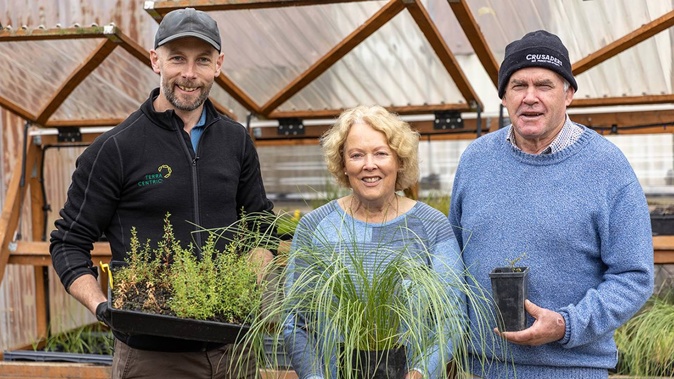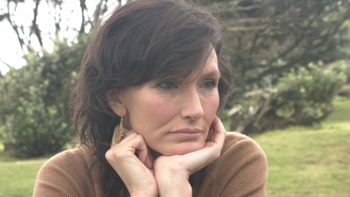
A nursery initiative to empower Waimakariri Irrigation Limited shareholders to grow native seedlings has proven successful on a Swannanoa farm.
Brian and Rosemary Whyte have grown more than 2000 plants during the last two years.
The initiative is part of a wider biodiversity project that aims to improve waterways throughout the irrigation co-operative’s scheme, with 297 sites of interest discovered during an initial biodiversity survey in 2018.
Key areas for restoration efforts include the Burgess Stream, Hunter’s Stream and the Cust River.
The native seedlings were planted along the first stretch of a 1.2-kilometre section of Burgess Stream which flows through the Whytes’ property and around a nearby irrigation buffer pond.
Waimakariri Irrigation Limited’s biodiversity project lead Dan Cameron said the site was an important part of the project due to its location near the springhead of the Burgess Stream.
“The restoration site is connected to the upper source of the Burgess Stream with four springheads converging to form the stream,” Cameron said.
“Once it gets to Brian and Rosemary’s property, it forms the main stem, and not far beyond here it leaves the boundary of the shareholder land.”
Cameron said the section of the stream chosen for the project had certain properties that made it ideal as an environmental restoration site.
“It’s relatively undisturbed, has a deep and wide well-defined riparian margin and stock has been excluded.
“There’s relatively moist soil near the water’s edge and meandering areas, which lend themselves to establishing the types of plant communities that would have been here before land use development.”
Cameron said these plants improved water quality by shading the stream and, in some cases, even assisting with the removal of nitrates from water in a way that complemented on-farm nutrient management.
“Carex secta colonises denitrifying bacteria in its roots which helps to naturally denitrify water and prevent sediment build-up.”
Back in 2019 when the first shareholder meeting was held at a neighbouring farm, the Whytes weren’t sure what the biodiversity project would involve.
However, they were happy for Cameron to visit their property and haven’t looked back since.
Brian said he was particularly interested in attempting to propagate the native broom that grew along the roadside of their property and planting it along the banks of their restoration site.
“When Dan first visited, I showed him the native broom that was growing along the road,” he said.
“Getting seed off it and managing to grow some in our greenhouse has been quite thrilling for me.”
Cameron said one of the highlights of working with the Whytes was being able to reverse the decline of indigenous biodiversity and witnessing the broom naturally regenerate at the planting site.
“Being able to harvest seeds from the native broom and growing what would have been naturally growing in the area before land use development is something quite rare.
“What is even more exciting is seeing broom naturally pop up at the planting site.”
The Whytes have enjoyed growing a range of native seedlings suitable for the conditions at their planting site.
The couple have grown New Zealand flax (harakeke), Edgar’s rush (wiwi), Carex secta (pūrei), toetoe, and cabbage tree (tī kōuka) in a raised greenhouse which contains a canopy roof and a watering system.
The only part of the process that was a bit tedious was the pricking out of individual seedlings, but Rosemary said having help from Cameron, as well as Swannanoa School, had made the process easier.
“When you have 500 seedlings to plant out it takes a while, which is why we were so grateful to have help from Swannanoa School, Dan, and a church youth group,” she said.
“Giving younger people a chance to get their hands in the dirt and plant something is important.”
With most of the planting around the wet margins of the stream edge completed, the focus is now on the sections further up the banks.
Different seedlings are being grown for this area as the bank is exposed to hot dry winds and is composed of free-draining soils.
Cameron is testing out ribbonwood seedlings for this area as they will be suitable for the conditions at Swannanoa, which is prone to hot northwest winds and minimal rainfall over the warmer months.
“In the first year, we stuck to what we knew would work best but in the second year, we branched out a bit.”
Ribbonwood was a woody species that was more tolerant of less moisture and heat, he said.
“Ultimately, we want to be able to shade the stream which will prevent the growth of weeds along the edge of the stream and in the water.”
Brian Whyte viewed biodiversity initiatives as having intergenerational benefits.
He encouraged other farmers to get involved.
“I think for me, it is the joy of something starting off as a seed, then potting it up and seeing it grow into a plant, then later it is ready to plant out on your site.
“Doing it yourself is a great thing and seeing my grandkids get involved is positive too.
“When the trees they planted are 20 feet high they will look back and appreciate the planting work that we did together.”
- The Country
Take your Radio, Podcasts and Music with you









